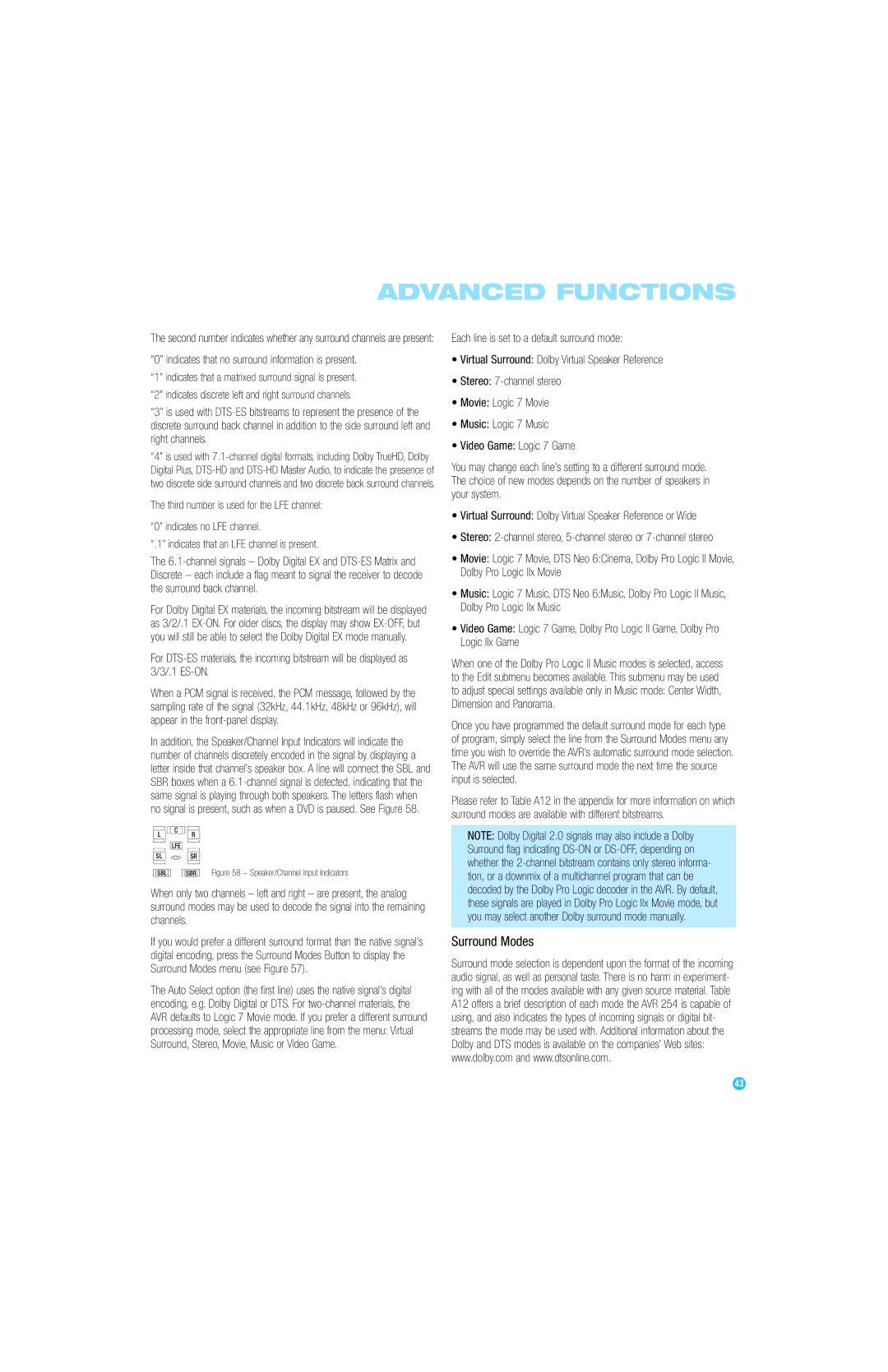
ADVANCED FUNCTIONS
The second number indicates whether any surround channels are present:
“0” indicates that no surround information is present.
“1” indicates that a matrixed surround signal is present.
“2” indicates discrete left and right surround channels.
“3” is used with
“4” is used with
The third number is used for the LFE channel:
“0” indicates no LFE channel.
“.1” indicates that an LFE channel is present.
Each line is set to a default surround mode:
•Virtual Surround: Dolby Virtual Speaker Reference
•Stereo:
•Movie: Logic 7 Movie
•Music: Logic 7 Music
•Video Game: Logic 7 Game
You may change each line’s setting to a different surround mode. The choice of new modes depends on the number of speakers in your system.
•Virtual Surround: Dolby Virtual Speaker Reference or Wide
•Stereo:
The
For Dolby Digital EX materials, the incoming bitstream will be displayed as 3/2/.1
For
When a PCM signal is received, the PCM message, followed by the sampling rate of the signal (32kHz, 44.1kHz, 48kHz or 96kHz), will appear in the
In addition, the Speaker/Channel Input Indicators will indicate the number of channels discretely encoded in the signal by displaying a letter inside that channel’s speaker box. A line will connect the SBL and SBR boxes when a
| L |
| C |
| R |
| |||
|
|
|
|
| |||||
|
|
|
|
|
|
|
|
|
|
|
|
| LFE |
|
|
|
|
|
|
|
|
|
|
|
|
|
|
|
|
|
|
|
|
|
|
|
|
|
|
| SL |
|
|
| SR |
| |||
|
|
|
|
|
|
|
|
| Figure 58 – Speaker/Channel Input Indicators |
|
|
|
|
|
|
|
| ||
| SBL |
|
| SBR |
| ||||
When only two channels – left and right – are present, the analog surround modes may be used to decode the signal into the remaining channels.
If you would prefer a different surround format than the native signal’s digital encoding, press the Surround Modes Button to display the Surround Modes menu (see Figure 57).
The Auto Select option (the first line) uses the native signal’s digital encoding, e.g. Dolby Digital or DTS. For
•Movie: Logic 7 Movie, DTS Neo 6:Cinema, Dolby Pro Logic II Movie, Dolby Pro Logic IIx Movie
•Music: Logic 7 Music, DTS Neo 6:Music, Dolby Pro Logic II Music, Dolby Pro Logic IIx Music
•Video Game: Logic 7 Game, Dolby Pro Logic II Game, Dolby Pro Logic IIx Game
When one of the Dolby Pro Logic II Music modes is selected, access to the Edit submenu becomes available. This submenu may be used to adjust special settings available only in Music mode: Center Width, Dimension and Panorama.
Once you have programmed the default surround mode for each type of program, simply select the line from the Surround Modes menu any time you wish to override the AVR’s automatic surround mode selection. The AVR will use the same surround mode the next time the source input is selected.
Please refer to Table A12 in the appendix for more information on which surround modes are available with different bitstreams.
NOTE: Dolby Digital 2.0 signals may also include a Dolby Surround flag indicating
Surround Modes
Surround mode selection is dependent upon the format of the incoming audio signal, as well as personal taste. There is no harm in experiment- ing with all of the modes available with any given source material. Table A12 offers a brief description of each mode the AVR 254 is capable of using, and also indicates the types of incoming signals or digital bit- streams the mode may be used with. Additional information about the Dolby and DTS modes is available on the companies’ Web sites: www.dolby.com and www.dtsonline.com.
43
